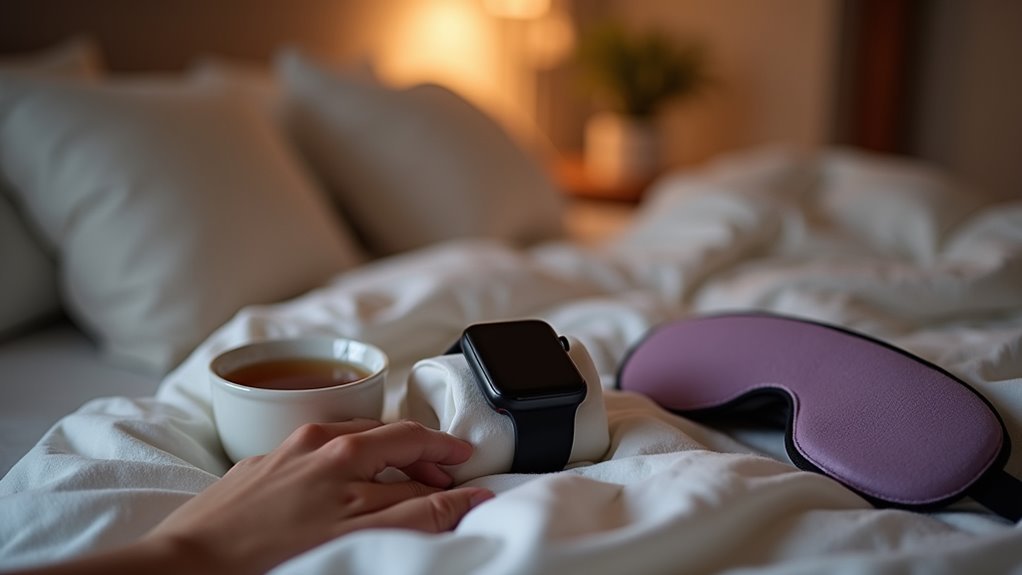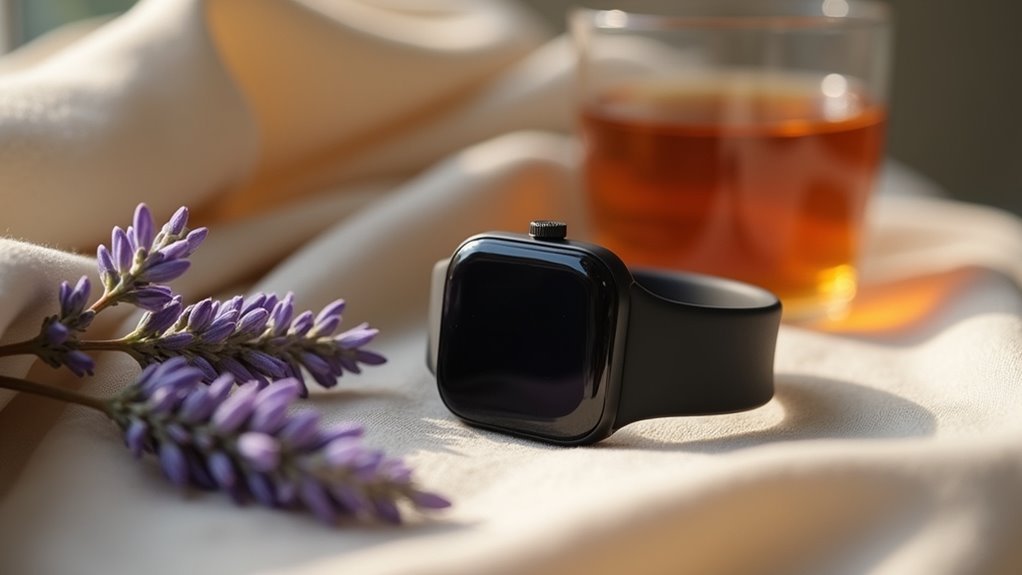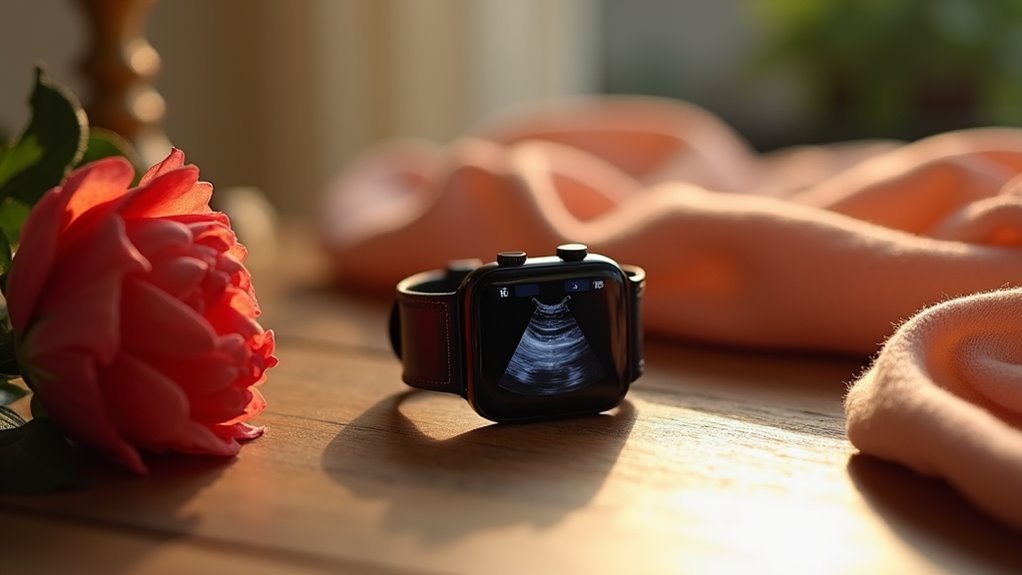You can track menopause symptoms with specialized wearables like the Peri patch that monitors hot flushes, Oura Ring for temperature and sleep tracking, Apple Watch Series 10 with third-party menopause apps, and WHOOP’s perimenopause journal features. These devices use temperature sensors, AI algorithms, and heart rate monitoring to detect hot flashes, analyze sleep disruptions, and track essential signs changes. Apps like Balance, Caria, and MenoLife integrate with wearables to provide thorough symptom analysis and personalized insights for better management.
Types of Wearable Devices for Menopause Tracking
As menopause symptoms become increasingly recognized as manageable health conditions, wearable devices have emerged as powerful tools for tracking and understanding these changes.
You’ll find several specialized options designed for your specific needs. The Peri Wearable offers a patch-style design that directly monitors hot flushes and night sweats.
The Peri Wearable’s innovative patch technology delivers targeted monitoring specifically for hot flushes and nighttime temperature fluctuations.
If you prefer jewelry-style devices, the Oura Ring provides perimenopause-friendly biometrics while letting you annotate data with tags like HRT, hot flashes, and mood swings.
The Apple Watch Series 10 tracks essential biometrics but requires third-party apps for thorough menopause management.
WHOOP enables you to toggle between perimenopause and postmenopause states in their journal feature, while general fitness trackers monitor activity and sleep patterns relevant to symptom management. Companies like Oura and Clue are collaborating with research institutions to advance understanding of menopause through biodata collection and symptom tracking.
Hot Flash Detection and Management Features
While hot flashes remain one of menopause’s most disruptive symptoms, modern wearable technology transforms how you can detect, track, and manage these episodes.
Temperature and humidity sensors embedded in wristbands or smart clothing continuously monitor your physiological changes, capturing localized temperature spikes and sweating patterns in real-time.
Advanced algorithms analyze this data through triple dimension analysis, measuring frequency, duration, and intensity of your hot flashes. AI-powered pattern recognition helps identify your personal triggers and timing, enabling predictive alerts before episodes occur.
Devices like Embr Wave 2 provide targeted cooling relief, while the Amira Terra System specifically addresses night sweats to improve your sleep quality. Many users find that continued use leads to improved effectiveness as they adapt to the device’s temperature regulation features.
You’ll receive personalized feedback and management strategies based on your unique symptom patterns, giving you greater control over these challenging experiences.
Sleep Pattern Monitoring During Menopause

Beyond managing hot flashes during waking hours, menopausal women face equally challenging sleep disruptions that can considerably impact their overall well-being.
Wearable devices like the Oura Ring and Apple Watch now offer extensive sleep tracking specifically designed to address these challenges. These devices monitor sleep stages, duration, and nighttime disruptions while detecting environmental factors that interrupt your rest.
Advanced sleep tracking technology in wearable devices provides menopausal women with comprehensive monitoring of sleep patterns and environmental disruption factors.
You’ll receive personalized insights through AI-driven analytics that correlate poor sleep with specific menopausal symptoms like night sweats. The data helps identify patterns and provides sleep quality scores for easy trend monitoring. Tracking symptoms is essential for managing health during the transition, as it helps in identifying patterns that can inform treatment plans.
You can share detailed sleep reports with healthcare providers for personalized care recommendations. Specialized devices like Peri patches and Embr Wave 2 target perimenopausal women’s unique sleep needs, helping you achieve better rest despite hormonal fluctuations.
Body Temperature Regulation Technology
Since hot flashes remain one of menopause’s most disruptive symptoms, advanced wearable technology now focuses on continuous body temperature monitoring to predict and manage these sudden thermal episodes.
Devices like the Oura Ring and Tempdrop track your body temperature around the clock, helping you identify patterns in temperature fluctuations that signal incoming hot flashes.
The Embr Wave takes a different approach, providing immediate cooling or warming sensations to your wrist when you’re experiencing temperature-related discomfort.
You can annotate your data to link specific temperature changes with symptoms, creating a personalized understanding of your body’s responses.
While these devices offer valuable insights, their accuracy varies based on placement and your individual physiology, so you’ll want to take into account these factors when choosing your monitoring solution. Additionally, it’s important to carefully review data usage terms before committing to any device, as the rapid evolution of femtech may outpace privacy and security measures.
Heart Rate and Vital Signs Tracking
You’ll notice significant changes in your heart rate variability during menopause as hormonal fluctuations affect your cardiovascular system.
Your heart rate patterns may become less consistent, making it harder to predict how your body responds to stress and daily activities.
Modern wearable devices can now track these variations alongside blood pressure monitoring, giving you real-time insights into how menopause impacts your essential signs. Apps like Balance enable symptom tracking of cardiovascular changes alongside other menopausal symptoms, helping you monitor patterns over time.
Heart Rate Variability Changes
As estrogen levels decline during menopause, your heart rate variability (HRV) undergoes significant changes that can affect your daily well-being. You’ll experience fluctuations in heart rhythm and palpitations as hormonal shifts impact your autonomic nervous system. Reduced vagal control becomes more pronounced with severe symptoms, leading to lower HRV readings.
| HRV Measure | Mild Symptoms | Severe Symptoms |
|---|---|---|
| RMSSD | Higher values | Lower values |
| pNN50 | Increased | Decreased |
| HF (High Frequency) | Elevated | Reduced |
| Vagal Control | Maintained | Withdrawn |
| Symptom Intensity | 42% experience palpitations | 54% experience palpitations |
Your wearable device can track these HRV changes, helping you understand symptom severity. Lower HRV indicates greater autonomic imbalance, while higher readings suggest milder menopausal effects. Monitoring these patterns enables early detection of potential cardiovascular health issues before they become more serious concerns.
Blood Pressure Monitoring
While most consumer wearables don’t continuously monitor blood pressure directly, they provide valuable heart rate and essential sign data that can help you track cardiovascular changes during menopause.
Devices like Fitbit and Garmin offer heart rate tracking that’s particularly useful for managing stress-related symptoms common during this change.
You can use this data to identify patterns and triggers for symptoms like hot flashes or anxiety episodes. When integrated with menopause-focused apps, your wearable’s crucial sign monitoring creates an all-encompassing health picture that supports better symptom management. Advanced AI algorithms can even help detect and predict hot flash episodes by analyzing patterns in your heart rate and other biomarker data.
- Tracking your resting heart rate fluctuations during sleep disturbances and night sweats
- Monitoring stress levels through heart rate spikes when hot flashes begin
- Observing cardiovascular responses during hormone-related mood changes and anxiety
Patch-Style Wearables for Symptom Management
Breakthrough technology in menopause care has arrived with patch-style wearables that revolutionize how you monitor and manage symptoms.
These discreet devices track hot flashes and night sweats through advanced sensors, providing objective data about your physiological changes.
Advanced sensor technology delivers precise, real-time tracking of menopausal symptoms, transforming subjective experiences into measurable physiological data.
You’ll receive personalized insights that help you understand how lifestyle habits impact your symptoms. The patch design guarantees comfortable daily wear while continuously monitoring fluctuations throughout your menopause changeover.
Data-driven feedback empowers you to develop tailored wellness strategies.
Peri, a CES 2025 Innovation Awards Honoree, exemplifies this technology’s potential. You can share collected data with healthcare providers to inform treatment discussions and guide personalized care plans.
These innovative solutions address underserved areas in women’s healthcare that have long been overlooked by traditional medical approaches.
These innovative wearables transform symptom management from guesswork into informed decision-making, ultimately improving your quality of life during menopause.
Wristband Devices for Temperature Control
Revolutionary wristband technology transforms how you manage menopause-related temperature fluctuations through immediate, on-demand thermal relief.
The Embr Wave 2 delivers clinically-validated cooling and warming sensations directly to your wrist, providing non-pharmacological relief from hot flashes and night sweats. You’ll experience personalized comfort through app-controlled temperature modes that adapt to your specific triggers.
This discreet device resembles jewelry, operating silently while delivering up to 9 hours of battery life. You can activate relief with a single button press, making it perfect for public settings or nighttime use. Clinical studies demonstrate that users report 2x improvement in control over hot flashes compared to managing symptoms without the device.
- Feel instant cooling waves flowing across your skin during sudden hot flashes
- Experience gentle warmth radiating from your wrist during temperature drops
- Enjoy silent, jewelry-like comfort that seamlessly integrates into your daily routine
AI-Powered Symptom Detection Capabilities
You’ll benefit from machine learning algorithms that analyze your temperature patterns to identify subtle changes preceding hot flashes.
These AI systems can send you predictive alerts minutes before symptoms occur, giving you time to prepare or take preventive measures.
Your device learns your unique physiological patterns over time, creating personalized symptom recognition that becomes increasingly accurate as it gathers more data about your body’s responses. Advanced hormone monitoring systems utilize AI powered insights from millions of data points to provide personalized tracking of FSH, LH, and other key hormones during menopause transitions.
Machine Learning Temperature Analysis
While traditional symptom tracking relies on subjective reporting, machine learning algorithms now transform how wearable devices detect and analyze menopause-related temperature changes. Your device continuously monitors skin temperature and heart rate variability, using AI to identify patterns that signal impending hot flashes.
These algorithms learn your unique thermoregulatory responses, recognizing subtle temperature fluctuations that occur before you even notice symptoms. Machine learning models analyze your declining estrogen’s impact on temperature regulation, tracking how your body’s sweating threshold changes throughout menopause.
The AI processes data from brown adipose tissue activity and environmental factors, creating personalized predictions about when hot flashes will occur. Healthcare providers can now analyze patient data more efficiently, reducing the time needed to identify effective treatment patterns and adjust personalized treatment plans based on your device’s continuous monitoring insights.
- Your smartwatch detecting a 0.5°F skin temperature rise thirty seconds before you feel the heat
- AI algorithms mapping your personal hot flash patterns across different sleep cycles
- Temperature sensors identifying your shifting thermoneutral zone throughout hormonal changes
Predictive Hot Flash Alerts
Before you feel that familiar wave of heat building, AI-powered predictive alerts are already analyzing your physiological data to warn you of an approaching hot flash.
These sophisticated algorithms continuously monitor your skin temperature and biometric signals through wearables, detecting subtle precursors before visible symptoms manifest.
Devices like Amira’s Terra System use this predictive technology to activate cooling preemptively, while the Embr Wave 2 provides controlled thermal sensations to reduce symptom severity.
The AI learns your unique patterns over time, improving alert accuracy and minimizing false alarms.
You’ll receive timely notifications that trigger automatic device responses or allow you to implement cooling strategies early. Testing showed that 50 women reported improved sleep quality when using these predictive cooling systems.
This proactive approach reduces discomfort severity, improves sleep quality, and decreases the stress of unpredictable symptoms.
Personalized Symptom Pattern Recognition
Beyond single hot flash predictions, AI-powered wearables now create extensive maps of your entire symptom landscape.
These devices analyze vast amounts of your health data to identify complex patterns you’d never notice on your own. The AI integrates information from sensors, health records, and your self-reported symptoms to build a thorough picture of your menopausal journey.
Your wearable’s natural language processing capabilities offer personalized advice on treatment options and lifestyle modifications. The technology even incorporates genomic data to tailor recommendations to your unique genetic factors, helping detect potential health risks like bone mineral density loss before they become serious problems. Some platforms now integrate with Mayo Clinic technology to provide evidence-based education on menopause management and treatment options.
- Your device tracking sleep disruptions, mood swings, and temperature spikes simultaneously
- AI detecting subtle connections between your stress levels and symptom intensity
- Personalized alerts suggesting dietary adjustments based on your symptom patterns
App Integration for Comprehensive Tracking
As menopause symptoms fluctuate throughout your daily routine, integrating specialized apps with wearable devices creates a powerful combination for thorough health tracking.
You’ll find apps like Caria, Balance, and MenoLife synchronize seamlessly with your wearable device, combining physical activity data with symptom patterns for extensive insights.
This integration lets you track over 40 symptoms alongside heart rate, sleep quality, and activity levels on one platform. You can customize tracking parameters, analyze severity trends, and download detailed health reports for medical consultations.
Many apps offer cross-platform compatibility, ensuring your fitness tracker or smartwatch works regardless of brand.
Cross-platform compatibility means your existing fitness tracker or smartwatch will work seamlessly with menopause tracking apps, regardless of device brand.
The enhanced user experience provides a holistic health view, helping you make informed decisions about symptom management while accessing community support and expert content. These symptom trackers can help document experiences for better doctor consultations.
Sensor Technology in Menopause Wearables
The sensors powering modern menopause wearables represent a sophisticated fusion of temperature detection, humidity measurement, and biochemical analysis that transforms how you monitor your symptoms.
Temperature sensors track skin heat fluctuations during hot flashes, while humidity sensors measure sweat levels to correlate with vasomotor symptoms. Microfluidic biosensors analyze your sweat composition, including hormone levels like estradiol, providing objective data without invasive blood tests.
These multi-sensor arrays combine physiological and behavioral data through sensor fusion, enabling predictive capabilities that anticipate hot flashes before they occur. You’ll benefit from continuous monitoring that captures sleep disturbances, anxiety levels, and activity patterns simultaneously. Some devices now provide automatic cooling relief by detecting early physiological changes and delivering targeted temperature interventions to minimize symptom impact.
- Smart clothing embedded with wireless sensors discretely monitoring temperature changes across strategic body areas
- Wearable patches with automatic valves regulating sweat flow for stable hormone readings
- Machine learning models processing real-time data streams to predict symptom onset
Personalized Insights and Data Analysis
While sophisticated sensors capture your physiological data, it’s the intelligent analysis layer that transforms raw measurements into actionable health insights tailored specifically to your menopause journey.
AI algorithms process your wearable data to predict symptom flares and identify triggers linked to worsening experiences. You’ll receive personalized recommendations for habit changes, such as improving sleep patterns or reducing stress, based on your unique symptom profile. The system adapts over time, learning from your responses and refining suggestions.
Your app creates visual dashboards showing symptom trends and correlates physical activity with symptom changes. AI flags unusual biometric patterns that may indicate health shifts, while long-term tracking reveals seasonal variations and recurring symptom clusters. This comprehensive data collection addresses the historical research gaps that have left many women without adequate understanding of their menopausal transitions.
This thorough analysis helps you understand your body’s patterns and make informed decisions about self-care strategies.
Benefits of Continuous Symptom Monitoring
Beyond collecting data, continuous monitoring through wearable devices transforms how you experience and manage menopause by delivering measurable improvements in symptom severity and frequency.
You’ll notice significant reductions in hot flushes and other menopausal symptoms as your device enables timely adjustments to lifestyle and treatment plans.
This enhanced awareness strengthens your communication with healthcare providers through detailed, accurate symptom records that support collaborative decision-making. Real-time symptom tracking through wearable technology provides the comprehensive data needed for personalised care approaches that address your unique menopause experience.
You’re empowered to identify triggers and patterns, fostering proactive health-seeking behaviors that boost your confidence in managing menopausal changes.
Pattern recognition through continuous monitoring empowers you to take control of your menopause journey with confidence and precision.
- Your morning coffee routine becomes optimized as you discover caffeine triggers hot flushes at specific times.
- Sleep patterns emerge clearly, revealing how evening workouts improve rest quality and reduce night sweats.
- Medication timing adjustments become precise, guided by real-time symptom data showing peak effectiveness windows.
Future Innovations in Menopause Tracking Technology
Emerging technologies are revolutionizing menopause tracking by moving far beyond basic symptom logging into predictive, personalized healthcare management.
You’ll soon access devices like Peri by identifyHer that predict hot flashes before they occur, giving you proactive control over symptoms. AI algorithms will analyze your real-time data to recommend personalized diet, exercise, and supplement adjustments tailored specifically to your hormonal fluctuations.
Future wearables will integrate seamlessly with smart home health ecosystems, combining menopause tracking with extensive wellness monitoring including bone density and cardiovascular health. Companies like Oura are already leveraging data from 100,000 female members to better understand perimenopause impacts and optimize tracking capabilities.
You’ll benefit from non-hormonal treatment recommendations based on continuous sensor data, expanding your management options beyond hormone replacement therapy. By 2025, market-ready devices will transform menopause from a passive experience into an actively managed health stage.
Frequently Asked Questions
Are Menopause Tracking Wearables Covered by Health Insurance Plans?
You’ll likely pay out-of-pocket for menopause tracking wearables since most health insurance plans don’t cover them. They’re classified as wellness devices rather than medically necessary equipment, limiting reimbursement eligibility.
How Much Do Specialized Menopause Wearable Devices Typically Cost?
You’ll spend $278-$500 for specialized menopause wearables like the Oura Ring 4 or Apple Watch Series 10. WHOOP 4.0 requires monthly subscriptions starting at $30, while Embr Wave costs around $299.
Can Wearable Devices Accurately Predict When Menopause Will Begin?
You can’t rely on current wearable devices to accurately predict when menopause will begin. They’re designed to track existing symptoms rather than forecast onset, though future AI advancements might change this.
Do Menopause Wearables Work for Women Taking Hormone Replacement Therapy?
Yes, menopause wearables work while you’re taking HRT. They’ll track your physiological changes, monitor symptoms like hot flashes, and help your healthcare provider adjust your treatment plan based on real-time data.
How Long Should I Wear These Devices to See Meaningful Results?
You’ll need consistent use for several weeks to see initial patterns, but meaningful results typically emerge after 2-3 months of regular tracking, allowing you to identify symptom trends and hormonal fluctuations effectively.




Leave a Reply